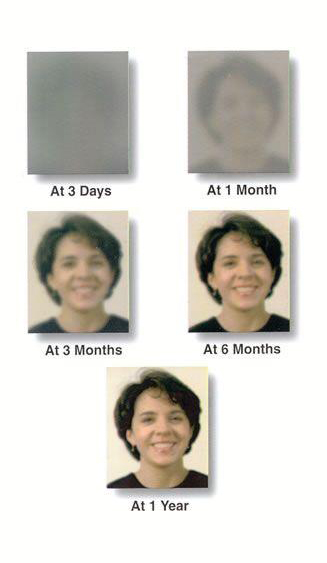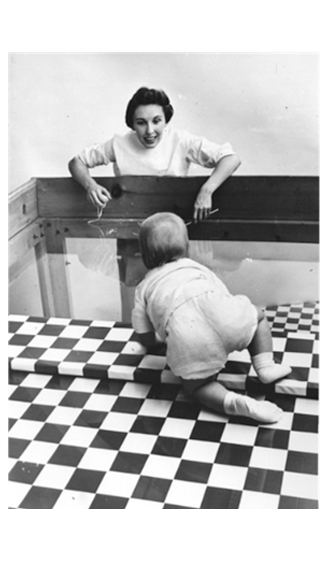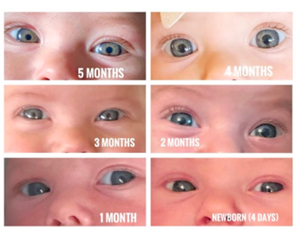By Dr. Christina Murray, O.D. — founder of Center for Better Learning in Coconut Creek, FL. Dr. Murray is originally from Columbus, Ohio, and is a proud graduate of The Ohio State University. She happily escaped the cold Ohio winters to attend optometry school at Nova Southeastern University. While in school, she discovered her passion for pediatrics and vision therapy. She is currently finishing up her board certification from the College of Optometrists in Vision Development.
One of the most common questions I get from parents is what their newborns and infants can see. The thought of an infant going from the warm, cozy darkness of a mother's womb to a loud, cold world of bright lights and blurry shapes seems jarring to new parents. Though this may be true, rather than being paralyzed by sensory overload, research suggests infants’ development of visual skills during their time in the womb prepare them to use their visual skills immediately. Doctors and nurses use this early visual alertness in the delivery room to assess the function of the central nervous system.
During the first year of development, visual development can be divided into four stages:
Adjusting to the World/Learning to Look

During the first few weeks of life, the visual system is already rapidly developing. At birth, they can already perceive light and shapes and detect motion. Their pupils are very small, limiting the light entering their eyes. Within a couple of weeks, their pupils widen, and the infant can better detect patterns of light and dark. At this age, infants prefer high-contrast black-and-white images and bright colors.
Most infants are born nearsighted with a visual acuity of around 20/200-20/400. Their best visual acuity is for objects located 8-10 inches from their eyes, which is the perfect distance for looking into mom and dad's eyes. The infant's brain is wired to process and recognize the human face from birth. The T-shaped facial pattern specific to mom or dad (distance between their eyes and from their eyes to her mouth) and the high contrast outline of their face and hair play into recognition. Studies have shown that newborns prefer their mother’s faces two weeks after birth. By two months, visual acuity improves to 20/150.
Newborn babies do not have control of their eyes. It is normal for their eyes to drift and even cross for the first few months of life. After the first month of life, an infant should begin to follow slowly moving lights, faces, and objects at near distances. infants over one month prefer visual stimuli that are in motion rather than stationary.
Coordination between Eyes, Brain, and Hands

At this stage, an infant can hold their gaze on an object for longer amounts of time. This allows for depth perception to begin to emerge. The infant can follow moving lights, faces, people, and objects with both eyes together. They can scan between three or more objects, and the eyes begin to move independently from the head. Despite their new ability to look, reach, and grasp, their aim, and accuracy won’t be great.
The newfound skills in following and grasping for objects promote their eyes to start working together and for eye-hand coordination to emerge. Infants become self-aware around two months of age with the awareness of their hands. They begin to reach out for things. Their movements begin to be more purposeful around three months of age. By the end of the fourth month, the appearance of wandering or crossed eyes should be gone.
By four months, visual acuity improves to 20/60, and color vision becomes close to adult-like levels.
Changing Focus
Most of us are lucky enough where our eyes work without ever needing to think about them. While wearing your appropriate optical correction, if required, no matter where you look, you see. There is no conscious thought required. Using a series of visual efficiency and visual processing skills, our eyes and brain work together to take in and process everything around us. Seeing requires good visual acuity, but vision requires a complex network of integrated skills to use the information our eyes send to our brains. To appreciate this process's complexity, think about what happens when driving a car.
At the same time, adult-like levels of eye teaming are developing, also known as stereopsis. An experiment found that most infants over six months would not cross from the shallow side to the deep side of a visual cliff created by plexiglass over a checkerboard pattern. This study proved that infants have a strong sense of depth perception by six months.
As the infant grows, the visual acuity reaches the adult standard of 20/20 by six months. They further refine their ability to move their eyes and more accurately follow moving objects.
Seeing to Move
Infants are developing a greater awareness of their overall body and learning to coordinate vision with their body movements.
Vision involves more than eye movements, eye teaming, and eye focusing. It is a whole-body process involving movements of the eyes, head, and body. To see a target, infants must orient their bodies toward it, rotate their heads to bring it into the field of view, and point their eyes to fixate on it. Development from sitting to crawling to walking can help or hinder this process by restricting where the eyes are in space and where they point. Developmental changes in eye height and range of head motion can influence what an infant sees.
During this stage, the color of the eyes may change as well. Many babies are born with blue eyes. Over time dark pigment is produced, making the baby’s eyes darker. Most babies have their permanent eye color by nine months old. However, some can take up to 3 years to become a permanent eye color.

If you would like to make an investment that lifts lives, brightens futures and strengthens the community, consider helping us. Please use the donate buttons below to select a secure method of online payment through PayPal, which allows donations by debit or credit card (PayPal keeps a two percent transaction fee for each donation).